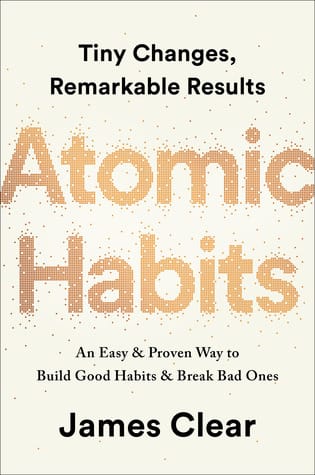Atomic Habits by James Clear

The book Atomic Habits by James Clear just like its author's name is very clear about its chosen topic: Atomic Habits. From its cover page, the book promises one thing: Tiny Changes, Remarkable Results: An Easy and Proven Way to Build Good Habits and Break Bad Ones.
To fulfill this promise, the book first of all teaches the foundations of habit forming:
Cue, Craving, Response, Reward.
That is to say, every habit begins with a cue: some sort of trigger, that prompts a craving: that is a desire, to which you respond: with a particular action, and for which you are rewarded: with something you like. For example, the smoking habit may have stress as its cue, followed by a desire to smoke, that is a craving, to which the smoker responds by lighting up a fag, and is rewarded by the relief brought on by the nicotine in the cigarette.
Because this series of actions is rewarded, the brain quickly memorizes it. So now, whenever the smoker is stressed in the future, he/she is going to feel like smoking and the rest follows on from there. After the author establishes this foundation, he begins to teach the real lessons of the book which build upon his theory of habit formation.
Step 1: Make it Obvious
This may seem in itself obvious, but if you want to start a new habit, start by putting its Cue in an obvious place. If you want to journal everyday, consider putting your diary in an obvious place on your table where you will see it everyday. If you want to start running for exercise, consider placing your running shoes by the door, so you get reminded every time you want to go out.
It might take a little reorganization of your living space to get the right cues in the right places but making your habits obvious to yourself, is always a great place to start.
Similarly, if you want to get rid of a habit, do the opposite, and make it invisible. Keep your cigarettes hidden, or your alcohol, or your snacks, or whatever it is you're trying to stop doing. The less visible the cue to that habit is to you, the less likely you will fall into the habit of doing it.
Step 2: Make it Attractive
This rule ties into the craving portion of habit formation. If you want to begin to do something regularly, make it something you will want to begin to do. Keep your water in that thermos flask so that it's chilled every time you want a drink, and you will soon find yourself drinking water more often. My mom recently started doing this so I know it works.
And of course the opposite works just as well. Only stock that flavor of ice cream that you hate, and you will consequently, eat less ice cream.
Step 3: Make it Easy
Here is where I learnt about an interesting approach called the Two-Minute Rule. Make any habit you want to start so easy that you could do it in two minutes. Want to go running? Make the habit to put on your running shoes and step outside. Want to start cooking? Make the habit to go into the kitchen and choose an easy recipe you like.
If there's any habit you want to start, just cut it short to the two minutes that get you committed. This makes the idea less overwhelming and more easy to start. Over time of course, you can increase what you do. Put on your running shoes, go outside, and run for thirty minutes. Then 1 hour. And so on, and so forth.
Step 4: Make it Satisfying
So far we've covered the cue, craving, and response, part of a habit. Now comes the final part: reward. This could be as simple as actually rewarding yourself every time you do your thing. Eat your favourite snack every time you complete a journal entry. Grab a Frappuccino at the end of your run... This puts something to look forward to at the end of your habit, and hopefully over time, instead of just looking forward to the end of your habit, you will begin to look forward to the habit itself.
Conclusion
I really enjoyed reading Atomic Habits. Not only because it gave me a framework for habit building, but also because of the way the book was written itself. The were many useful tips and tricks such as Habit intentions & Habit stacking, and at the end of each chapter was a review of all the lessons shared.
This made it easy to retain the content. So easy in fact, that I have written this whole article without referring back to the book once. I am sure that I may have missed out on a few key points that could help you along... but that's for you to buy the book and find out! After all, authors need to make their money somehow.
This year, I'll be trying out some of these habit forming tricks to make a difference in my life. I hope that they will be useful to you too.
